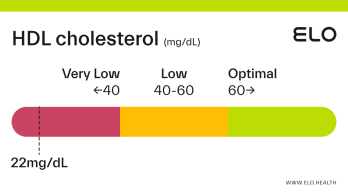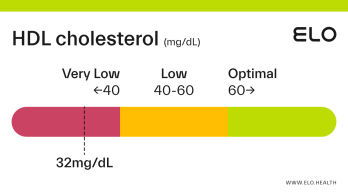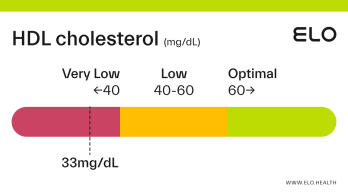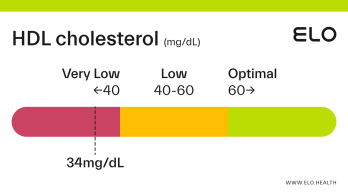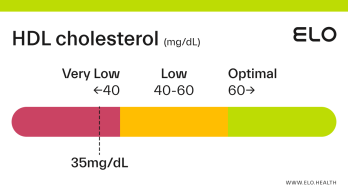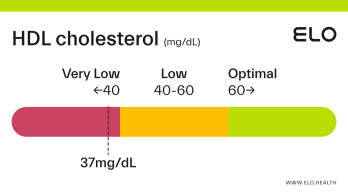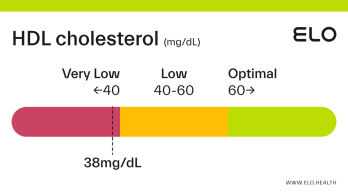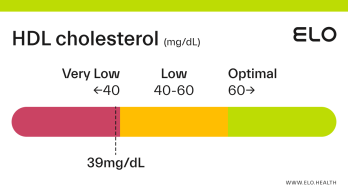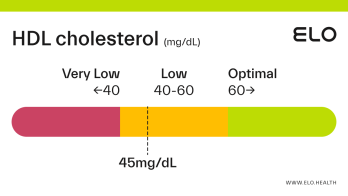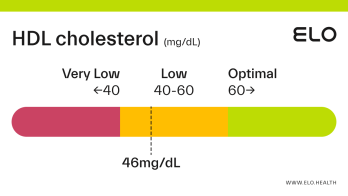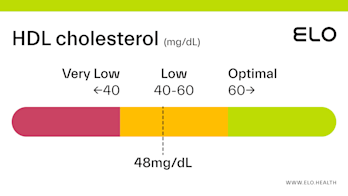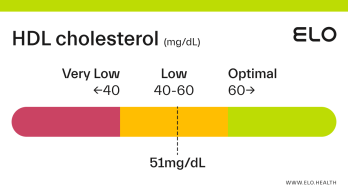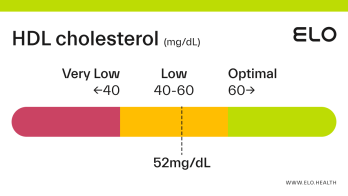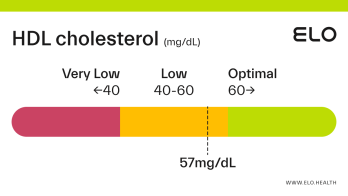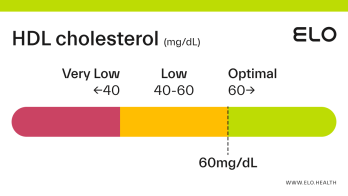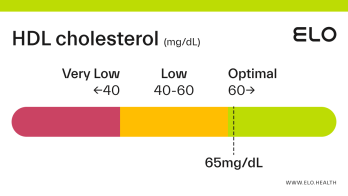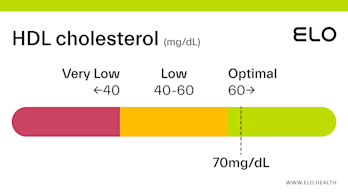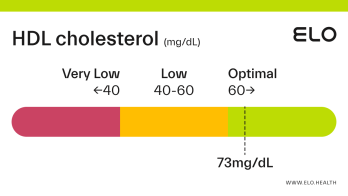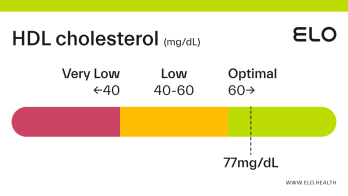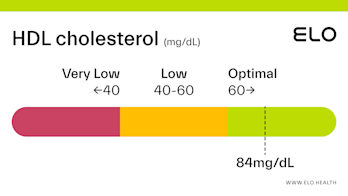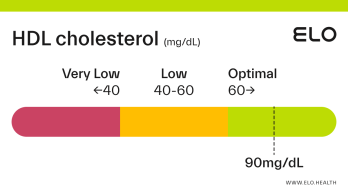HDL cholesterol overview

What is the test?
HDL cholesterol is a test that measures the amount of high-density lipoproteins (“good cholesterol”) in your blood.
What does it measure?
This test measures the amount of protective HDL cholesterol in your blood. HDL promotes heart health by removing LDL (“bad” cholesterol”) from your bloodstream and carrying it back to the liver, where it is broken down and removed from the body. Higher levels of HDL cholesterol are associated with a lower risk of heart disease. The higher your level, the better.
What do your HDL results mean?
HDL cholesterol status is classified as follows:
Very low: <40 mg/dL
Low: 40-60 mg/dL
Optimal: >60 mg/dL
Very low HDL results:
HDL cholesterol levels below 40 mg/dL are considered very low. Very low HDL cholesterol in combination with elevated LDL cholesterol (>100 mg/dL) is associated with an increased risk of heart and blood vessel diseases, including heart disease, heart attack, stroke, and sudden cardiac arrest [2]. If your HDL cholesterol is very low, diet and lifestyle modifications can help increase your levels back into the acceptable or optimal range without the need for medications.
Low HDL results:
Low HDL cholesterol levels are between 40-60 mg/dL, though this varies by age and sex. For men over 20 years of age, the low range is 40-60 mg/dL, and for women, 50-60 mg/dL. Diet and lifestyle changes may help you increase your HDL levels to >60 mg/dL, which has protective benefits and lowers your risk for coronary artery disease and stroke.
Optimal HDL results:
Optimal HDL cholesterol levels are >60 mg/dL. Having higher levels of HDL cholesterol level is associated with a lower risk of heart disease. Strangely though, people who naturally have extremely high HDL levels (>100 mg/dL) appear to be at higher risk of heart disease that may be related to genetic factors [6].
What factors impact HDL levels?
A variety of factors can affect HDL levels, including your diet, weight, physical activity level, and whether or not you smoke. Medications, certain diseases, and your age, sex, race, and genetics also impact HDL levels.
Diet: Diets high in saturated fats, trans fats, added sugar, and low in fiber can lower HDL levels.
Weight. Having excess fat, particularly around the abdomen, can lead to lower levels of HDL cholesterol.
Physical Activity. Being active can help raise HDL cholesterol levels and lower LDL levels.
Smoking. Smoking lowers your HDL cholesterol which can contribute to a higher level of bad cholesterol.
Medications: Some medications can lower HDL levels in some people. These include beta-blockers (a standard blood pressure medicine), anabolic steroids (including testosterone), progestins (found in some birth control pills and hormone replacement therapy), and benzodiazepines (used for anxiety and insomnia).
Metabolic disease/ uncontrolled diabetes: Metabolic disease and uncontrolled diabetes can cause lower HDL levels.
Age and Sex: Women tend to have higher HDL levels than men, though levels tend to decrease after menopause.
Genetics (heredity): Family members commonly have similar cholesterol levels, suggesting your genes can raise your risk of unhealthy cholesterol levels. Though rare, very low HDL cholesterol levels can also be inherited. Medical conditions that severely lower HDL levels include Tangier’s disease and familial hypoalphalipoproteinemia.
Race. Hispanic Americans are more likely to have lower HDL levels, whereas Blacks/African Americans are more likely to have higher levels [8]. However, other risk factors, such as high blood pressure, obesity, or diabetes, may overcome the health benefit of higher HDL levels.
Alcohol: Some evidence suggests moderate alcohol consumption may increase HDL levels [6]. For healthy adults, that means up to one drink a day for women of all ages and men older than age 65, and up to two drinks a day for men aged 65 and younger [6].
Groups at risk for low HDL cholesterol
Those with a diet high in saturated fats, trans fats, and added sugar, and with low fiber intake
Overweight or obese individuals
Physically inactive adults
Smokers
Individuals taking certain medications like beta-blockers, anabolic steroids, progestins, and benzodiazepines
Those with a family history of low HDL/high LDL cholesterol, heart disease, heart attack, and stroke
Health conditions including metabolic disease, uncontrolled diabetes, Tangier’s disease, and familial hypoalphalipoproteinemia can also lower HDL.
Diet & lifestyle strategies shown to improve HDL results
To increase HDL cholesterol levels:
Exercise for 30-60 minutes 5x/week
Eat more fiber, particularly from beans and whole grains
Avoid trans fats, like hydrogenated oils, and limit saturated fats
Eat small, fatty fish at least twice a week
Lose excess weight
Quit smoking
Manage stress and get adequate sleep
Medications and supplements used to improve HDL results
Medications
Medications are not usually prescribed for low HDL levels alone. This is because most cholesterol medications target “bad” LDL cholesterol and triglycerides. HDL levels may increase from drugs used to lower LDL and triglyceride levels, however. Some of these include:
Fibrates: Help lower high triglyceride levels but may also help raise your HDL cholesterol.
Statins: Statins (including atorvastatin, simvastatin, and rosuvastatin) reduce cholesterol production in your liver, lowering blood cholesterol levels. Because they typically need to be taken for life, statins are only prescribed if diet and lifestyle changes aren’t enough [3].
Supplements
Niacin: Niacin is a B vitamin that can improve HDL levels and lower triglyceride levels when taken at prescription doses, although niacin therapy does not appear to reduce heart disease events, like heart attacks or strokes [9]. It works by blocking the enzyme responsible for making cholesterol in the liver.
(Algal) omega-3: Taking algal oil rich in the omega-3 DHA might help increase HDL cholesterol and lower triglycerides; however, it also seems to increase LDL (bad) cholesterol [10]. Most research has involved patients without heart disease.
Turmeric: A spice commonly used to flavor and color curry dishes, turmeric may help increase HDL and lower pro-inflammatory markers, LDL cholesterol, and triglycerides [11]. More research is needed to determine optimal form and dosage but supplementing with 500 mg/day appears safe and potentially beneficial cholesterol.
References
Cholesterol Levels: What You Need to Know. (n.d.). U.S. National Library of Medicine | NIH. Retrieved September 9, 2021, from
https://medlineplus.gov/cholesterollevelswhatyouneedtoknow.html
Carotid Artery Disease. (n.d.). National Heart, Lung, and Blood Institute | NIH. Retrieved September 9, 2021, from
https://www.nhlbi.nih.gov/health-topics/carotid-artery-disease
High cholesterol. (n.d.). NHS Inform. Retrieved September 9, 2021, from
https://www.nhsinform.scot/illnesses-and-conditions/blood-and-lymph/high-cholesterol
Racette, S. B., Lin, X., Lefevre, M., Spearie, C. A., Most, M. M., Ma, L., & Ostlund, R. E., Jr (2010). Dose effects of dietary phytosterols on cholesterol metabolism: a controlled feeding study. The American journal of clinical nutrition, 91(1), 32–38.
https://doi.org/10.3945/ajcn.2009.28070
Cholesterol: Types, Tests, Treatments, Prevention. (2020, July 31). Cleveland Clinic.
https://my.clevelandclinic.org/health/articles/11920-cholesterol-numbers-what-do-they-mean
HDL cholesterol: How to boost your “good” cholesterol. (2020, November 10). Mayo Clinic.
https://www.mayoclinic.org/diseases-conditions/high-blood-cholesterol/in-depth/hdl-cholesterol/art-20046388
HDL: The “Good” Cholesterol. (2019, April 18). National Institutes of Health.
https://medlineplus.gov/hdlthegoodcholesterol.html
Blood Cholesterol | NHLBI, NIH. (2021, January 4). National Institutes of Health.
https://www.nhlbi.nih.gov/health-topics/blood-cholesterol
Schandelmaier, S., Briel, M., Saccilotto, R., Olu, K. K., Arpagaus, A., Hemkens, L. G., & Nordmann, A. J. (2017). Niacin for primary and secondary prevention of cardiovascular events. The Cochrane database of systematic reviews, 6(6), CD009744.
https://doi.org/10.1002/14651858.CD009744.pub2
Bernstein, A. M., Ding, E. L., Willett, W. C., & Rimm, E. B. (2012). A meta-analysis shows that docosahexaenoic acid from algal oil reduces serum triglycerides and increases HDL-cholesterol and LDL-cholesterol in persons without coronary heart disease. The Journal of nutrition, 142(1), 99–104.
https://doi.org/10.3945/jn.111.148973
Qin, S., Huang, L., Gong, J., Shen, S., Huang, J., Ren, H., & Hu, H. (2017). Efficacy and safety of turmeric and curcumin in lowering blood lipid levels in patients with cardiovascular risk factors: a meta-analysis of randomized controlled trials. Nutrition Journal, 16(1), 68.
https://doi.org/10.1186/s12937-017-0293-y

